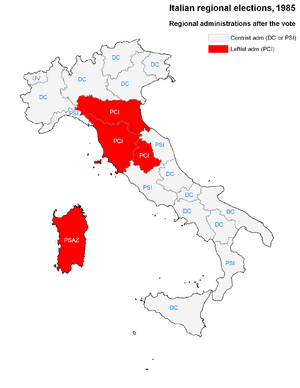Italian regional elections, 1985
| | ||||||||||||||||||||||||||||||||||||||
| ||||||||||||||||||||||||||||||||||||||
| ||||||||||||||||||||||||||||||||||||||
|
| ||||||||||||||||||||||||||||||||||||||
| Regional election results map. White denotes regions with a centrist (Christian Democratic-Socialist) administration, Red denotes those with a leftist (Communist) administration. | ||||||||||||||||||||||||||||||||||||||
The Italian regional elections of 1985 were held on May 12. The fifteen ordinary regions, created in 1970, elected their fourth assemblies.
Electoral system
The pure party-list proportional representation had traditionally become the electoral system of Italy, and it was adopted for the regional vote too. Each Italian province corresponded to a constituency electing a group of candidates. At constituency level, seats were divided between open lists using the largest remainder method with Droop quota. Remaining votes and seats were transferred at regional level, where they was divided using the Hare quota, and automatically distributed to best losers into the local lists.
Results
Summary of the results of all the lists reaching at least a tenth of the suffrages.
The most relevant result of these elections was the switch of Piedmont, which returned to the Christian Democracy after ten year of leftist administration. If the vote weakened both two major parties, the DC could compensate its loss with the reinforcement of its national allies, while the Communists became increasingly isolated, with Craxi's Socialists looking definitely at their right. Twelve Regional Councils elected a centrist administration, with the PSI rewarded by four presidencies, while the PCI was confined to its traditional strongholds: Emilia, Tuscany and Umbria.
The results strengthned Craxi's government after the alarming results of the 1984 European election, and they underlined the decline of the Communist party into a progressively post-industrial Italy.


